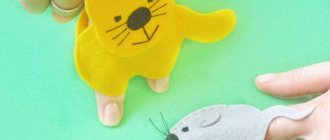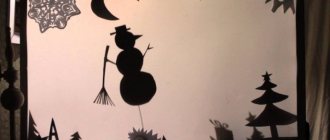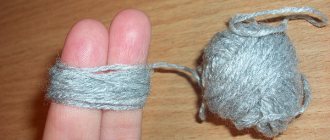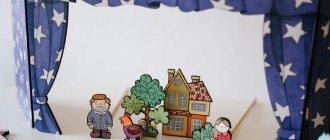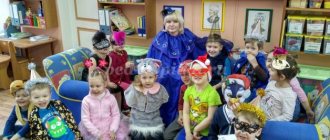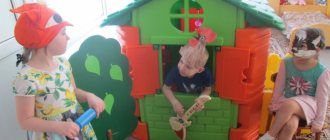Tatyana had been eyeing a children's tabletop theater for a long time. There were several reasons. Firstly, her favorite dreamer, three-year-old Alice, simply dreamed of the theater. Especially after they attended two magical performances in the interactive Baby Theater. Secondly, mother and daughter rented a house in the village for the whole summer: away from the bustle of the city, the asphalt bursting from the heat and tireless cars fidgeting back and forth. And thirdly, perhaps this is the most important reason: although the rented dacha was neat and well-built, drafts on the floor were not eliminated. And Tatyana was very afraid of these same drafts. If you don’t keep an eye on your daughter, there’s sneezing, sniffles, and coughing.
They took enough toys for the holiday, a whole bag, fortunately the family car was carrying all this stuff. And so, having seated their daughter at the table, they decided to play theater. There are not enough heroes for any particular fairy tale. Let's improvise: mom starts, daughter continues:
- Lived once…
— Little Bunny Igoreshka and Fox Frosya...
“We lived together amicably, never quarreled, and then one day I came to them...
- Puppy Kulichik... Mom, where did they live? - Suddenly Alice is distracted from the fairy tale. - Our table is completely empty.
No, but the little girl was right. Our theater is not really a theater. It's boring without decorations. We set off to look for suitable material for the house. Oh, what luck! Cardboard boxes are piled in the closet. I think the owners won’t be offended if my daughter and I borrow one for a theater screen house. We cut out a window, a door. The house is ready. We put it on the table.
“Mommy, this is some kind of sad house,” Alice pouts. “Igoreshka doesn’t want to live here.”
- Why doesn’t he want to? – Tatyana doesn’t understand.
- He's not handsome! – the daughter quickly blurts out and looks slyly at her mother.
Yes, that afternoon, we didn’t manage to play the children’s tabletop theater. But until the evening, mother and daughter are busy. Mom is making a roof for the house, her daughter is enthusiastically decorating... Everyone is busy!
When Alice goes to bed in the evening, Tatyana, sighing, looks at the awkward scenery and realizes that she will soon need more: trees for the forest, a hut, a fire, the sun, a path, a palace. Yes, we can’t change everything over the summer. But there is a way out: Google to the rescue. Tatyana quickly places several orders, pays, and the details will be sent by mail to the local post office.
Websites for purchasing scenery, props and characters for tabletop theater for children:
- Modern toys
- Everything for your child
- OZON
- Child's world
- Daughters Sons
- Labyrinth
Interesting facts about tabletop children's theaters
Tatyana can't sleep. Despite the order being placed, I want to know something more about the tabletop theater for children. She searches Yandex and Google until midnight. The picture is interesting, it turns out:
- Tabletop theater also refers to other types of children's theater: finger theater, shadow theater, puppet theater, and bench theater.
- The tabletop theater appeared much earlier than the table that we are used to seeing at home, and which we cannot do without.
- The tabletop children's theater is slightly younger than the classic theater for adults. Children attended performances for adults, and then played memorable scenes and events. We can say that the tabletop theater was invented by the children themselves.
- A drawn paper doll with clothes among the sheets of a school notebook is a prototype of the flat tabletop theater of Soviet children.
- When a child takes a toy in his hand and begins to perform some actions and give lines for it, this is already a table theater. Despite the fact that the child can play under the table.
- Characters and scenery can be very diverse: flat, three-dimensional, semi-voluminous. They can stand on a table, be worn on a hand, suspended or attached to a support.
- The general standard for characters is the height of the figures, which is recommended to be no more than 30 centimeters.
- Characters and scenery do not have to be purchased. You can make them yourself from quite ordinary materials that are always at hand: paper, cardboard, fabric, yarn, natural materials (pebbles, twigs, cones).
All children's lives are “communicating vessels.” If a child draws a lot, using different materials, it is easier for him to subsequently perceive the works of great artists. And vice versa: observation (a term that was once introduced into pedagogical artistic practice by the artist and teacher B.P. Nemensky) is reflected in the children’s drawings. It’s the same with music: those children who are introduced to playing musical instruments learn to hear music earlier and more attentively than others.
Modern Russian psychologists who study children's play advise parents to teach their children to play. The main argument: in the last century, children received playing lessons from communication in groups of different ages. And there were many children in the families. Now “naturally formed” mixed-age communities (for example, courtyards) have disappeared from our lives. Rare families have more than two children. Therefore, the burden of teaching the game falls on the parents. In the books of psychologist Elena Smirnova you can find tips on how to stimulate children’s play, how to help them build simple plots. The famous expert on children's games, Elena Kravtsova, has a book “Awakening the Magician in a Child”: in it, parents are told about all sorts of “tricks” that stimulate the development and complication of the game plot.
For example, you can ask what is happening in the game at the moment and unobtrusively suggest new plot moves: “Does the driver want to take this cargo to distant countries - where something is really needed?..”, “Shouldn’t you go for your daughter’s birthday in a neighboring kingdom? What should she do for this? and so on.
In some cases this works. But it’s not always possible to interfere in children’s play. Here, at least, two circumstances are necessary: the parent must show interest in the game, and the child must feel his interest (and not the desire for didactic testing) and the desire to allow an outsider (even a close one) into his game.
If a parent, with the consent of the child, joins the game, if he himself is interested in playing and at the same time does not suppress the child’s initiative, great.
But in general, it is difficult to interfere in the game - since it is a creative and therefore intimate process. And if you have to intervene, if a four-year-old (and even more so a five-year-old) child needs to be told plot moves, if he cannot build a play space without the intervention of an adult, then for some reason the child has not learned to play. A child who cannot play is a separate problem and a separate conversation. (You can immediately assume that he will have problems with learning to read. And almost certainly with independent reading of books.) I would like to think that these are exceptional situations.
However, you need to have a “backup” tool that allows you to influence the situation. It is good in any case - both with wonderful development and with some problems.
*** This means is a tabletop theater. Not finger, not puppet, not “dramatization games”, but theater on the table. This is such a wonderful form, akin to acting as a director (actors are little toys) and connected to the book text.
For example, the text of a small fairy tale can be reproduced almost verbatim in a tabletop theater. But unlike in the book, the characters on the tabletop stage acquire volume and some “freedom” of movement; the figures move back and forth, “talking.”
When showing a child such a performance, we depict how the characters snort, sniff, squeak, tremble, fall, etc. – i.e. “we complete” the text through additional movements and sounds, endowing it with those mimic, non-verbal qualities that are characteristic of live communication, but are absent in the book.
A theatrical action has more opportunities to “capture” and hold attention than a book. This form also works in cases where, for various reasons, it is difficult for children to sit in one place while listening to a book. This form makes it easier to perceive and remember the text.
And with her help, we teach the child how to act as a director and demonstrate her model. It is assumed that the child will not only watch the performance (at first let him watch - this is also a useful skill), but at some point he will also take part in it. Various moves are possible here: to bring what is happening closer to a theater game, to seat spectators (dolls and stuffed animals) in front of the stage. Or you can simply “show” the performance to each other.
You can immediately instruct the child to drive a “talking” character, you can provide him with a doll that doesn’t say anything special, but only taps, squeaks, falls, and jumps. It all depends on the desires and capabilities of the child.
Almost all children can imitate the actions of the character (even a rather complex set): tapping and squeaking is a pleasure.
A tabletop performance always has additional, “super-programmed” capabilities – something that is not provided for in the author’s text: for example, a bow. Or suddenly it turns out that a character (let it be a frog) utters an unexpected remark: “Oh, I’m tired! Where should I lie down? What would the crib be made from? Knock-Knock. This is where I'll go to sleep. Mouse, mouse, are you tired? Do you want to sleep?
It’s difficult not to answer – even in monosyllables.
And the adult is “distracted” - you see, and the child is already speaking for two characters. Some new life began on stage.
*** For a tabletop theater, you need dolls, which will then move into the child’s director’s games.
In general, a child needs “literary” toys.
They help the child “act out” experiences and at the same time create their own stories. If such a doll is included in the game, it “drags” something from its book stories there and at the same time, being among other toys, contributes to the development of “new” relationships (sometimes a showdown, but this is also a plot).
True, among purchased toys there are few characters from favorite books. And they are often not commensurate with the space of the director's play. She needs small toys.
At some point I found myself in a toy museum in the former Palace of Pioneers on Vorobyovy Gory. And I was surprised to find out that in the sixties, Soviet industry tried to solve this problem: entire sets of literary characters were produced. For example, almost the complete cast of characters from the fairy tale “Cipollino”. These were exact copies of the images drawn in the book. (Another thing is that the lucky ones who owned this set in childhood are not known to me. Only the collector who collected these dolls one by one throughout Russia. And “Cipollino” was published in a single form. The drawings of the first edition set the canonical images.)
Later, in the 80s, sets of small figures based on Russian folk tales appeared - “The Wolf and the Seven Little Goats”, “Masha and the Bear”. They still exist – in different forms.
But this is clearly not enough.
Well, okay. The lack of toys in some cases can turn into a pedagogical discovery. After all, a tabletop theater is also a field for joint productive activities of parents and children. (Productive activity in psychology is the creation of some kind of “handmade” product. This includes modeling, drawing, design, etc.)
Such activities, it would seem, are not directly related to the development of speech and familiarization with the book. But the child’s words, for the most part, are born from his experiences. The process of creating your own handmade “work” is incredibly exciting. It always seemed to me that Elena Makarova’s essays on her activities with children (modeling, drawing) are, in fact, exciting stories about the birth of meaningful speech. How interesting and unexpected the children expressed themselves in her classes!
What is this if not “the ability to express one’s attitude to what is happening,” which is considered the most important criterion for developed reading ability? By creating a tabletop theater, we organize life around a book. We create a body for book images, we build scenery for book plots. We allow the child to experience the birth of doll characters and fall in love with them with a new love. Our hand-made theater re-strengthens the child’s connection with the book plot, with the book. After all, the book is the hero’s birthplace.
Marina Aromstam
Why does a child need a tabletop children's theater?
Table theater for children is a fun and useful game that:
- Makes you think, improvise and fantasize, develops out-of-the-box thinking, and reveals creative potential.
- Ideally prepares your child for the difficult school days.
- Teaches you to concentrate and not switch from play to pranks, from pranks to games.
- Helps to think figuratively and recreate situations that a child faces when he leaves his mother’s cozy embrace and goes out into society.
- Capable of keeping a child occupied for a long time. My mother and I are preparing the scenery, characters and other props. We color it ourselves. We come up with a fairy tale before going to bed. Let's play a fairy tale. Don't forget to improvise.
- Suitable for spending time with one child, or for several, or for the whole family.
- Will keep the whole family occupied on long cold evenings when the weather is bad outside.
- Will entertain the baby during illness right in bed, when he cannot get up at the insistence of the doctor and mother.
- Packs quickly and compactly for long trips: to nature, to the countryside, to the sea. Only it is better to use flat heroes, made of cardboard, on a thick stand.
If your child doesn't already have their own tabletop theater, now is the time to create one to prepare for the upcoming winter with slush, wind and frost. Write your ideas in the comments and send photos of the scenery and characters!
Summary of children's leisure activities using a tabletop theater in the senior group
Fly, Cluttering Fly Gilded belly. The fly walked across the field, the fly found the money. The Fly sat down on a tree stump and began to daydream a little... The Fly.
What should I buy?
Maybe the car is cool? Dress, shoes and jacket... And I’ll buy some candy! Author. Here an ant crawls out of the grass towards the fly. (Ant doll appears) Ant.
Eh, you Tsokotuha Fly!
Gilded belly. You wanted a lot of unnecessary things! Educator.
Children, the ant turned out to be right.
Do you think it’s possible to want everything at once? (children's answers) Educator.
Every person has needs.
This is something that is necessary and cannot be avoided. The important needs for life are the “need” needs, and the ones we need to strive for are the “want” needs. You must be able to choose what you need most. Let’s help Mucha figure out what is important to purchase first, and what can be purchased later. Didactic game “I want, I need” Educator.
You and I will split into two teams.
One team will choose what is needed first, and the other team will choose what they want, but not very important, which they can do without. All pictures must be attached to the easel. (children attach subject pictures corresponding to the task to magnetic boards) Educator.
Thank you for helping Mukha understand her desires, correctly identifying the most important needs and what to strive for.
What about our Fly? Fly.
What should I do?
What do i do? How can Mukha continue to live? Ant.
Fly, Fly-Tsokotukha!
You don’t need to walk around the field every day, but start earning money with your labor! Author.
The Ant left to do his important business... And the Fly began to argue, Where to get money.
So as not to walk across the field, but to get a penny. (The ant leaves the bundle and leaves) Educator.
Tell me how to make money?
(children's answers) Educator.
What is the name of the main business that a person studied and then began to work?
(children's answers) Educator.
That's right, profession.
Let's tell Mukha what professions there are. Didactic game “Name the profession”
(The teacher draws the children’s attention to the knot. Unties the knot, finds objects of labor in it. Invites the children to correlate the tools with the profession to which they belong.)
Author.
Our clever little fly accepted all the advice.
We know how the Tsokotukha Fly loved to greet guests. She decided to open a forest cafe, where everyone will meet. I found craftsmen, found a clearing, and built a cafe there. Educator.
Let's help Mukha-Tsokotukha build a cafe.
Physical exercise “Builders”
1, 2, 3, 4, 5 Hands on the belt, turns right, left.
We are building a big, tall house! We stand on our tiptoes, stretch our arms up, install windows, and build a roof. “Draw” the window, show the roof. What a beautiful house! We show the gesture “class!” Mucha will be comfortable in it! Let's clap our hands. Educator.
Now we will go to the store to buy the necessary goods for the cafe.
What do we need in order to buy a product? (children’s answers) Didactic game “Buying goods”
On the counter there are dummies of vegetables, fruits, packages of milk, bread and other products. There are also various items - toys, pencils, artificial flowers, etc. All goods have price tags with a catchy designation (circles of the same color) of the price. Each child receives a wallet containing 5 coins. Children's task: - count how many coins: - select and buy the right product for the cafe and explain your choice; - count how many coins are left; -decide what else you can buy with the remaining coins. Children put all purchased goods in a basket.
